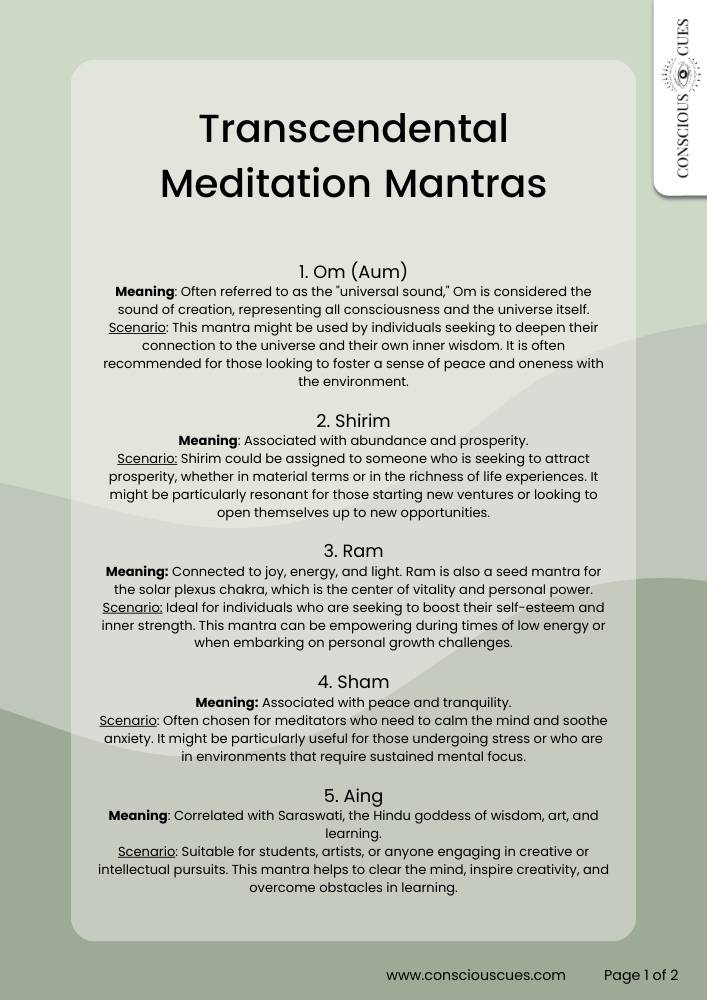Transcendental Meditation Mantra List PDF
So you’re curious about Transcendental Meditation mantras? Start your journey with our transcendental meditation mantra audio and explore deeper with the downloadable TM Mantras List PDF. Whether you’re beginning your TM practice or looking to deepen your existing meditation routine, these resources will help you understand and utilize TM mantras effectively to enhance mindfulness and reduce stress in your daily life. Listen to the audio guide now, and download the PDF for a comprehensive understanding of each mantra’s unique attributes and applications.
Listen Now: Transcendental Meditation Mantras
Get Your Copy: Transcendental Meditation Mantra List PDF
What Are Transcendental Meditation Mantras?
Transcendental Meditation (TM), a form of silent mantra meditation developed by Maharishi Mahesh Yogi, is widely recognized for its simplicity and profound impact on the practitioner’s psychological and physiological well-being. TM is practiced twice a day for 20 minutes, sitting comfortably with closed eyes. While the specific mantras used in TM are typically assigned individually by a certified TM teacher and are kept confidential, there are some general principles and considerations regarding TM mantras.
Mantras are specific sounds or vibrations that are used silently during meditation to facilitate deeper states of consciousness. A TM mantra is usually a simple sound, phrase, or word that is not intended to have a specific meaning, but rather to achieve a particular effect on the mind and body.
Benefits: Why Use TM Mantras?
-
- Promotes Deep Relaxation: TM mantras are designed to help individuals achieve a state of deep relaxation. The repetitive nature of mantra chanting helps to quiet the mind, reducing stress and anxiety. This process allows the body to release accumulated tension and promotes a state of physical and mental well-being.
- Enhances Self-Awareness: By focusing on the mantra, practitioners can transcend everyday thoughts and emotions, tapping into a deeper level of consciousness. This practice enhances self-awareness, enabling individuals to become more attuned to their inner selves and the subtle nuances of their mental state.
- Improves Focus and Concentration: Regular practice of TM with mantras can improve the ability to concentrate and focus. This is particularly beneficial in today’s fast-paced world, where constant distractions can lead to a scattered mind. TM practitioners often report improved attention spans and better cognitive function over time.
- Facilitates Emotional Healing: The soothing and repetitive use of TM mantras can have a healing effect on the emotional body. It helps in processing emotions and overcoming psychological patterns that can lead to depression and anxiety. Many find that regular TM practice brings emotional stability and resilience.
- Supports a State of Mindfulness: Although TM is different from mindfulness meditation, the focused repetition of mantras can cultivate a state of present-moment awareness. This practice helps individuals remain in the ‘now,’ enhancing their overall mindfulness throughout daily activities.
- Cultivates a Deeper Connection to the Self and the Universe: Many practitioners believe that TM mantras help connect them to a greater universal energy. This connection can lead to profound spiritual insights and a sense of peace and purpose that transcends everyday experiences.
- Scientific Support: Research studies have consistently shown that TM can have numerous health benefits, including lower blood pressure, reduced cortisol (stress hormone) levels, and improved heart health. These effects are enhanced by the specific use of mantras, which help regulate the body’s stress response and promote an overall sense of harmony and balance.
How to Use TM Mantras
1. Setting Up Your Meditation Space:
- Choose a quiet, comfortable spot where you will not be disturbed.
- Sit in a comfortable chair or on a cushion with your legs crossed.
- Keep your back straight but relaxed.
2. Beginning Your Meditation:
- Gently close your eyes and take a few deep breaths to settle your mind and body.
- Begin to silently repeat your chosen mantra in your mind without moving your lips or making a sound.
3. During the Meditation:
- Focus your attention on the mantra. If your mind wanders to other thoughts, gently return to the mantra.
- Let the repetition be effortless and relaxed. The mantra should be thought in a gentle, soothing manner.
4. Concluding the Meditation:
- After 20 minutes, stop repeating the mantra and sit quietly for a couple of minutes.
- Gradually open your eyes and take a moment before standing up.
5. Frequency of Meditation:
- Practice TM twice a day: ideally, once in the morning before breakfast and once in the afternoon before dinner.
Commonly Used Transcendental Meditation Mantras
Aum (or Om):
Often considered the most universal of all mantras, “Om” represents the sound of the universe and is used to connect with the cosmic, universal vibration. This mantra helps to unify the body, mind, and spirit with the surroundings, promoting a sense of peace and connectedness.
Shirim:
This mantra is traditionally associated with abundance and prosperity. Practitioners often use “Shirim” to focus their meditation on attracting wealth and prosperity or to enhance feelings of abundance in various aspects of life, not just material.
Ram:
Known for its association with joy, pleasure, and self-awareness, “Ram” is used to invoke these qualities during meditation. It helps deepen the connection to one’s inner self and can bring about a more joyful and energetically uplifted state of mind.
Sham:
This sound is often employed to induce a calming effect on the mind and to cultivate inner peace. It can be particularly beneficial for those dealing with stress or anxiety, as it helps soothe the nervous system and foster a tranquil mental state.
Aing:
Associated with Saraswati, the Hindu goddess of knowledge, music, arts, wisdom, and learning, “Aing” is used by practitioners who seek to enhance their intellectual abilities and creativity. It’s believed to open the mind to learning and absorbing new knowledge efficiently.
Kirim:
This mantra is thought to have a cutting or transformative power, helping to dispel illusions or obstacles. It can be used in meditations focused on overcoming challenges or obstacles, providing the mental clarity needed to see through deceptions and focus on truth.
Hirim:
Often linked to healing and purification, “Hirim” is believed to help cleanse the practitioner’s body and mind of toxins and negative influences. It’s used in meditations aimed at physical or emotional healing, promoting a sense of purification and renewal.
Soham:
This mantra translates to “I am That,” where “That” refers to all creation, which is a profound affirmation of unity with the universe. It is used to remind the practitioner of their connection to all living things and the universe, fostering a deep sense of inner peace and existential unity.
Vam:
Connected to creativity and emotional release, “Vam” can be particularly useful for those who are seeking to unlock creative energies or work through emotional blocks. It helps open up the mental faculties related to creative expressions and emotional processing.
Yam:
This mantra is centered around love and compassion. It is used to open the heart chakra and enhance personal and universal love. Practitioners often focus on “Yam” to develop greater compassion towards themselves and others, fostering deeper interpersonal connections and self-acceptance.
These mantras are tools that can be focused upon during meditation to achieve specific mental, emotional, or spiritual outcomes. They are powerful aids in the journey of personal growth and spiritual development, helping to align the practitioner’s vibrations with the energies they wish to attract or cultivate.
Tips for Integrating TM into Daily Life
- Consistency is Key: Regular practice is crucial in TM. Aim to meditate at the same times each day.
- Post-Meditation Routine: Allow yourself a few minutes after meditation to transition back to your daily activities smoothly.
- Journal Your Experience: Keep a journal to note your thoughts and feelings after each meditation session. This can provide insights into your mental and emotional patterns.
Transcendental Meditation is more than just a technique; it is a journey towards inner peace and self-realization. Whether you are a beginner or an experienced meditator, understanding and using mantras can significantly enhance your meditation experience.
Frequently Asked Questions
What is a TM mantra?
A TM mantra is a specific sound, word, or phrase used in Transcendental Meditation to help the practitioner focus and delve deeper into a state of pure consciousness. Each mantra is selected for its vibrational quality, not for any specific meaning.
How are TM mantras chosen?
In the official TM practice, mantras are given to individuals by certified TM teachers. The selection is based on a number of factors including age and personal needs, ensuring that the mantra resonates uniquely with the individual’s current state and life situation.
Can I choose my own TM mantra?
Traditionally, TM mantras are not chosen by the practitioner but assigned by a trained TM teacher during an initiation ceremony. This is to ensure that the mantra suits the individual’s unique psycho-physiological makeup.
Are TM mantras religious?
No, TM mantras are not religious. They are selected based on their sound quality and are used as tools to facilitate transcendence during meditation. They do not have any religious meaning and do not require any particular belief system to be effective.
Can I tell others my TM mantra?
It is recommended that TM practitioners keep their mantra confidential to preserve its integrity and effectiveness. Sharing it can externalize something that is meant to be a deeply personal and internal experience.
What if I forget my TM mantra?
If you forget your TM mantra, it is advised to reconnect with your TM teacher to ensure correct practice. TM teachers are available to help practitioners maintain the effectiveness of their practice through proper use of the mantra.
How do I use a TM mantra during meditation?
During TM, you gently repeat the mantra in your mind without force or effort. The mantra is used as a vehicle to help the mind naturally settle down, allowing you to experience deeper levels of awareness.
What are the benefits of using a TM mantra?
Using a TM mantra helps to reduce stress, calm the mind, and promote a state of relaxed awareness. Over time, practitioners often experience improved mental clarity, emotional stability, and heightened well-being.
How long do I meditate with the TM mantra?
The standard TM practice involves meditating twice a day, for about 20 minutes each session. Using the mantra during these sessions helps maintain a focused yet relaxed meditation experience.
Can I use a TM mantra outside of meditation?
While the mantra is primarily meant to be used during meditation sessions, some practitioners find that recalling their mantra during stressful situations helps bring them a sense of calm and focus.
Related Resources
Inner Child Work
What Is InnerChild Work?How Does ItWork?Inner Child WorkExercisesWhat Is TheInner Child?Inner child work is a healing practice that connects you to the sensitive, innocent, and playful child within you - your inner child. It’s like opening a dialogue with this part of...
Rewiring Your Brain: Neuroplasticity Exercises for Habit Change
Unleash the Potential of the Brain: Neuroplasticity In Action Understanding the Brain as a Tool In the vast landscape of human potential, our brain stands as a remarkable tool that holds immense power to shape our lives. It serves as the command center, processing...
Gut-Brain Connection 101: Debunking Myths, Unveiling Hidden Links, and Preventing Misdiagnoses
The gut-brain connection is not just fascinating; it's a fundamental aspect of our health that influences everything from our mood to how we digest food. In this comprehensive resource, we will explore the intricate relationship between our gut and brain,...
The Power of Affirmations: Unleashing the Science of Self-Transformation
In the journey of personal growth and self-discovery, affirmations have emerged as a powerful tool that can shape our thoughts, beliefs, and ultimately, our reality. Affirmations are positive statements that we repeat to ourselves consciously and consistently, aiming...
Inner Child Work 101: Reconnecting with Your Authentic Self
Have you ever felt like there's a part of you that remains hidden, yearning to be heard and acknowledged? Welcome to the world of inner child work - a transformative journey of self-discovery, healing, and growth. By reconnecting with your inner child, you can...
The Power of Neuroplasticity: Rewiring Your Brain for Conscious Living
In our fast-paced and ever-evolving world, the pursuit of conscious living has become a profound and meaningful endeavor. Essential to this lies the astonishing power of neuroplasticity—the brain's extraordinary ability to adapt, reorganize, and form new neural...






